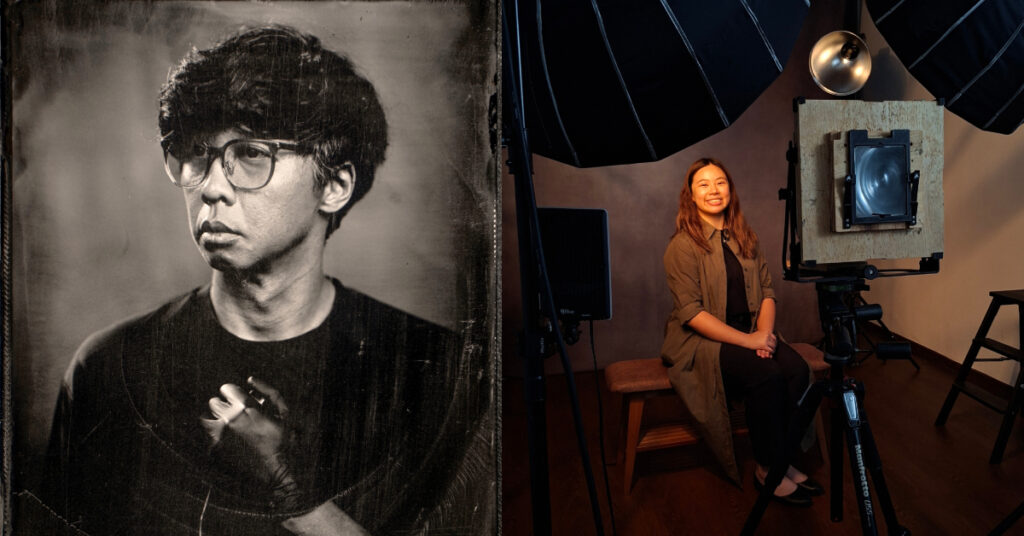
Meet the only person doing professional wet-plate tintype photography in Singapore
For Ryan Lee, some of his fondest childhood memories were made at family photo studios—choosing backdrops, adjusting poses, and waiting for prints to develop. But by the time he was about to get married, those old-school film studios had all but vanished in Singapore.
Feeling disheartened, Ryan promised himself that he would bring that tradition back. That promise took root when he stumbled upon a video of a photographer in San Francisco practising wet-plate tintype photography: an antiquated 19th-century process that captures hauntingly beautiful portraits on metal plates.
Inspired, Ryan left his job as a creative director and poured about S$150,000 of his savings into opening Hip Xiong Photo Studio at Geylang in Nov 2019. “I have been helping others build their brand for decades, and decided that it was time to build my own brand.”
Unfortunately, the COVID-19 pandemic hit just months after opening his studio, leaving Ryan to live off his savings until May 2020. Still, he refused to give up and spent three months researching the medium further, experimenting with chemicals, light, and timing until he perfected the process on his own.
When the world slowly reopened, Ryan’s studio drew curious visitors eager to experience the same old-world charm that inspired him in the first place.
I only had one shot, here’s how Ryan made it work
We reached out to Ryan to find out how he learnt the ropes and the process behind wet-plate photography, but he initially remained coy about it. “I prefer not to go into too much detail, I think it’s better for people to experience it themselves!”
And that’s precisely what I did: I booked a photoshoot for myself to see what it’s all about.
When I visited on a random Thursday morning, he warmly greeted me and led me upstairs to the second floor, where his studio and darkroom were located. He gave me a quick rundown on how the photoshoot would be conducted, and I sat down in the chair where he helped me with my posing and positioning.
I opted for the 4×5-inch tintype and paid S$300 for one plate, which meant I had only one chance to get the right shot. I don’t consider myself the most photogenic person, so I felt nervous and self-conscious walking into the studio. Despite that, Ryan took his time and patiently guided me, even chatting as he fine-tuned the lighting and focus, which helped me relax as the 45-minute session went on.

Then came the chemistry. In his darkroom filled with bottles, trays, and frames, Ryan prepared each frame by pouring a collodion solution diluted with ether and alcohol onto a black aluminium plate.
The plate was then placed into a canister of silver nitrate, where the silver particles bound with bromides and iodides from the collodion to form a film of silver halides—a compound also found in black-and-white photography.

“Essentially, we are making our own film,” said Ryan.
The film is seen as a tacky, white coloured emulsion that is sensitive to light and is loaded into the camera. After a three-second countdown and a flash of blinding light, we had our shot.
In the darkroom, Ryan poured a small amount of developer over the plate, turning the silver halides into metallic silver to create a negative image. Once the negative formed, he rinsed away the developer and poured on the fixer, dissolving the white emulsion to reveal the original black plate and my portrait.

While I might have moved slightly from my original position, I was pleased with how it turned out. It wasn’t the most polished picture I’ve ever had, but its imperfections and the effort behind it made the S$300 well worth it.
Learning a lost craft and passing it down
Not everyone is convinced that paying hundreds for one or two frames is justified. Ryan countered this by saying that his pricing reflects both the cost and the value of the experience.
“It’s a steal!” Ryan exclaimed. “It’s a very unique form of photography compared to a typical professional shoot that can cost thousands; my tintype sessions are more about offering a meaningful, one-of-a-kind experience for those who prefer a single, lasting picture rather than hundreds of shots.”
He explained that the materials and monthly rental account for roughly 40% to 50% of his costs, and that he charges for the time, care, and opportunity costs behind each shoot. However, achieving the results he wanted took consistent rounds of trial and error—a habit he has maintained for the last five years since he started.
Like a science experiment, every shot depends on multiple variables, from chemical concentration and humidity to temperature and even what colour clothing the subject wears. “I can tell you what type of lights and lenses I use, but you won’t get the same result,” added Ryan. “I am always making small improvements; the look of my earlier plates is very different from the ones I do now.”
As the craft was rare when he first started, Ryan often asked questions online, but received no replies. So he taught himself and became more self-reliant.”I learnt more through making my own mistakes. If people spoonfed me the answers, I would not have gotten to this point today.”
To the 44-year-old, time works differently when he’s in the darkroom. While the process looks and sounds tedious to many, Ryan finds it enjoyable to the point where he could spend hours finding the right combination of chemicals and timing there without realising.
“I had a end goal in mind and had a vision how I want my work to be, it was very satisfying that every little change that I make in the process brings me a step closer to what I wanted to achieve.”
As the only person doing wet-plate tintype photography in Singapore, Ryan now uses his studio as a platform to reintroduce locals and tourists to the craft. He conducts workshops where participants can make their own tintype portraits, having refined the process to make it accessible to anyone curious enough to try.
One of those workshops even led to a special opportunity. A participant from American beauty brand Kiehl’s attended a session and noted that wet-plate photography began in 1851: the same year the brand was founded.
That coincidence led Kiehl’s to host its anniversary celebration on the ground floor of Hip Xiong Photo Studio in 2021.
Starting again after a mini hiatus in 2024
All seemed to go well for the business, which was why I was surprised to learn that Hip Xiong Photo Studio stopped operating in 2024, four years after its inception. Ryan revealed that he decided not to renew the lease of his studio in November 2023, as he spent 80% of his time in the darkroom on the second floor, leaving the ground floor underutilised.
He had also been looking for a smaller, cheaper location that better suited his needs. “I had this impression that no matter where I am, if people really want my service, they’ll come to me,” he said. “So the location didn’t really matter.” The pet shop next door also wanted to expand and offered to take over the space. So, Ryan let it go.
But he didn’t stop practising. He began doing house calls, offering wet plate photography services directly to clients’ homes. It allowed him to reach people who couldn’t visit his studio, but it was exhausting work—the setup and transport of chemicals and equipment were back-breaking, and he had to charge higher prices to make each trip worthwhile.
As rental prices climbed, Ryan contemplated giving up wet-plate photography altogether. But then his former property agent called, offering him the chance to reclaim his old space at the end of 2024. He agreed without hesitation.

However, restarting from scratch proved challenging. Many post-pandemic customers were unfamiliar with wet-plate photography, and supply chain disruptions added another layer of frustration beyond his control.
Despite these hurdles, Ryan’s focus has never been on profit. Preserving wet-plate tintype photography and sharing it with like-minded people has always been his priority.
“I felt that if I wanted something so badly, maybe someone with the same mindset would want the same thing.”
- Learn more about Hip Xiong Photo Studio here.
- Read more stories we’ve written on Singaporean businesses here.
Also Read: The end of an era: 5 trades that have quietly died or are slowly disappearing in Singapore
Featured Image Credit: Hip Xiong Photo Studio
Last modified: October 14, 2025







